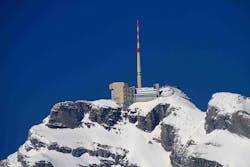Do you remember when the laser got you? What piece of technology or which expert made you choose a career in this field? I had almost forgotten about it, but last week I was reminded of my own pivotal point. It must have been in 1993, when I was studying physics at the Free University of Berlin. A team there had made a project to measure air pollution over big cities using an ultrashort-pulsed laser and a new technology called light detection and ranging (lidar). They made measurement campaigns around the world, using a laser system built into a van. They even started a company. That was cool enough to make me listen to a lecture series on ultrashort-pulsed lasers, and to write a thesis on this field. And so, the laser got me.
Now it's 2021, and I've come across a follow-up project: a team of scientists build a laser to catch a lightning bolt. The ultrashort-pulsed laser is steered in the sky, builds a plasma channel, and that should guide the flash to a huge telecom antenna on the Swiss mountain Säntis.
The scientific leader of the project is Jean-Pierre Wolf, a professor from Geneva University and the former CEO of Elight, which was the startup that built a commercial weather lidar in the early 1990s. While he had more than 30 years of experience in atmospheric laser research, it took a laboratory accident in Michigan in 1996 to set him off onto the filament idea. There, in the lab of Gérard Mourou and Donna Strickland, a mirror was broken and leaked intense short-pulsed laser radiation. Surprisingly, this laser beam made a kind of filament in air. It was a plasma, but not limited to a focal point. They played around and created a longer filament. Then, they went out on the floor—they could tweak the laser to create a filament as long as the whole floor, which was almost 100 ft., as the legend says. At that time, they did not send it outside.
There were others who tried that—for example, in the French-German project Teramobile in 2008. They managed to trigger electrical activity in thunderclouds, but they did not succeed completely, as their plasma channel did not live long enough for “real” lightning bolt guiding. An American team from the University of Arizona (UA; Tucson, AZ) and the University of Central Florida (UCF; Orlando, FL) tried it in 2014 with a femtosecond pulse followed by a nanosecond pulse. They all had great results on a scale of a few meters in a laboratory setting, but not in free nature. A lightning bolt needs milliseconds to build up on a scale of hundreds of meters, as Jean-Pierre Wolf told me. And that has not been established—yet.
It takes a big laser to catch a lightning bolt
In 2017, the European Union granted almost €4 million to build and test a laser to act as a lightning rod. This time, they wanted to have both the high intensity of a terawatt laser and the efficient energy deposition in the plasma channel through a high average power. German laser manufacturer Trumpf (in fact Trumpf Scientific, their branch for research projects) took over the construction of the required laser. The laser delivers 720 mJ pulses at a repetition rate of 1 kHz. The pulses are in the picosecond region, creating intensities at the terawatt level in the focus.
Most pieces of the huge laser system have already been transported to the top of mount Säntis with a funicular—just the telescope waits for helicopter transport, which has been circumvented by bad weather so far. The laser will be mounted on the eighth floor of the radom building beside the TV tower and ignite the plasma filament on top of the antenna’s tip.
Experiments are scheduled for summer 2021. Will they catch a lightning bolt? Jean-Pierre Wolf said at a recent press conference, “The atmosphere is always quite different from what we have in the lab” and “we will learn a lot about lightning mechanisms.” But he is optimistic that after 25 years of attempts, it will work this time. They just have to wait for a thunderstorm. Statistically, there are more than 100 thunderstorms on mount Säntis per year.Clearing the sky
Laser lightning research has been funded for more than 25 years. In Europe, there were grants from German, French, and European research organizations, and in America it was a Department of Defense grant. Within the new Laser Lightning Rod project, there are seven participants, including Airbus and the space company ArianeGroup. That points to expectations from the aerospace industry. As a rule of thumb, a lightning rod can protect an area with a diameter of its height. So, a laser lightning rod 1000 m high could protect a rocket launch site or the approach path of an airport, one might think. But Wolf thinks further: “Ground to satellite laser communication is of increasing importance. We would try to open them a clear optical channel in a cloud.” It remains an old dream to control a lightning bolt. Now watch the Swiss sky for a very straight flash this summer. If you see it, well, then it has happened.
About the Author
Andreas Thoss
Contributing Editor, Germany
Andreas Thoss is the Managing Director of THOSS Media (Berlin) and has many years of experience in photonics-related research, publishing, marketing, and public relations. He worked with John Wiley & Sons until 2010, when he founded THOSS Media. In 2012, he founded the scientific journal Advanced Optical Technologies. His university research focused on ultrashort and ultra-intense laser pulses, and he holds several patents.


